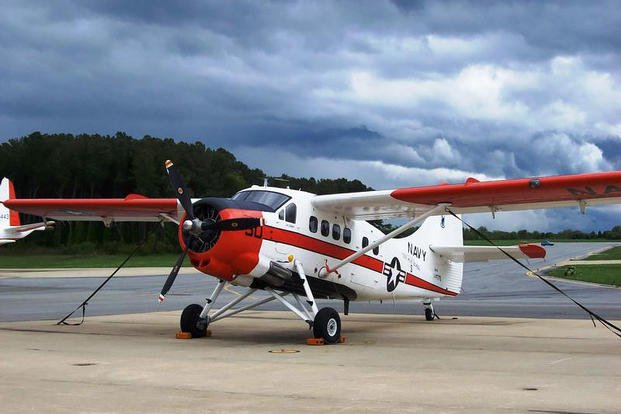Seen today in the pattern at Cambridge, MD (CGE), where Alson and I could be seen eating crabcakes......
Otter or Beaver?
Collapse
X
-
It seems this aircraft is venerable.....and our former Avisgger Paul (Naf) Nafzinger has a bunch of time in it from his days at Navy Test Pilot School/Pautuxent. It's highly modified to humble Naval Aviators....Naf wrote to me on FB:
Got quite a few hours in that bird. Was first AF exchange instructor at the Navy Test Pilot School. I was actually current in 7 aircraft at the same time. Try that today. We used it to humble fighter pilots.
Comment
-
Thanks, Reams. Reading up on it, I didn't realize that the Otter came stock with full span flaps and flaperons.Originally posted by Reams Goodloe View Post
Comment
-
Scott -
From the DHC-3 FLIGHT MANUAL... published by The De Havilland Aircraft of Canada Limited. Downsview, Ontario.
Issued July 1953
Updated 18 October 1985
With Pratt and Whitney Wasp R-1340 SiH1-G or S3H1-G
Geared, nine-cylinder, air cooled, supercharged radial.
Fuel Grade - 80/87 (or alternate fuel grades with lower or higher lead contents: 91/98, 91/96; 100/130 - permissible only when 80/87 is not available)
"1.10.1 WING FLAPS The wing flaps are of the full-span, double-slotted type.
The outboard trailing edge portions of the flaps are operated independently as
ailerons."
and
1.11 WING FLAPS HYDRAULIC SYSTEM.......
.........The wing flaps are mechanically connected to the trim tab on the left elevator so that
actuation of the wing flaps automatically deflects the trim tab to maintain the longitudinal trim.
"5.2.8 SLOW FLYING
The aircraft is fully controllable at its slow flying air speed of 80 mph
with flaps at CRUISE, 70 mph with flaps at LAND."
They also use stall dams on the top side of the wing, maybe 3/4 of the way outboard of the flaps.
Rack for boat or canoe approved with certified kit...!
- Reams-
Comment
-
It was right slow as it flared for landing....Originally posted by Reams Goodloe View PostScott -
From the DHC-3 FLIGHT MANUAL... published by The De Havilland Aircraft of Canada Limited. Downsview, Ontario.
Issued July 1953
Updated 18 October 1985
With Pratt and Whitney Wasp R-1340 SiH1-G or S3H1-G
Geared, nine-cylinder, air cooled, supercharged radial.
Fuel Grade - 80/87 (or alternate fuel grades with lower or higher lead contents: 91/98, 91/96; 100/130 - permissible only when 80/87 is not available)
"1.10.1 WING FLAPS The wing flaps are of the full-span, double-slotted type.
The outboard trailing edge portions of the flaps are operated independently as
ailerons."
and
1.11 WING FLAPS HYDRAULIC SYSTEM.......
.........The wing flaps are mechanically connected to the trim tab on the left elevator so that
actuation of the wing flaps automatically deflects the trim tab to maintain the longitudinal trim.
"5.2.8 SLOW FLYING
The aircraft is fully controllable at its slow flying air speed of 80 mph
with flaps at CRUISE, 70 mph with flaps at LAND."
They also use stall dams on the top side of the wing, maybe 3/4 of the way outboard of the flaps.
Rack for boat or canoe approved with certified kit...!
- Reams-
Comment
-
I recently started flying a Twin Otter for a skydiving operation and it is currently my favorite bird to fly. The STOL performance speaks for itself, but it's a great hauler, is arguably safer as a jump ship with its large cargo door and higher vertical stabilizer, and, best of all, it's way more manageable in a busy traffic pattern than the King Air.
Comment
-
That must be fun. I rode as pax in Twin Otters many times on commuter routes in the '80s. Them and Beech 99s.Originally posted by Dusty Rider View PostI recently started flying a Twin Otter for a skydiving operation and it is currently my favorite bird to fly. The STOL performance speaks for itself, but it's a great hauler, is arguably safer as a jump ship with its large cargo door and higher vertical stabilizer, and, best of all, it's way more manageable in a busy traffic pattern than the King Air.
Comment
-
I have a favorite visual snapshot memory from a B99. I'd just boarded when a lady stepped up the airstair, and obviously wasn't prepared for the diminutive size of the interior. Can still remember the wide eyes & open mouth...but she stiffened the sinew, summoned up the blood, and got on with it <g>.Originally posted by Scott Dyer HPN/NY View PostThem and Beech 99s.
Comment


Comment